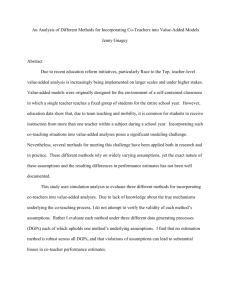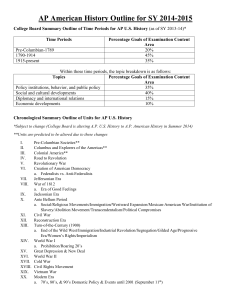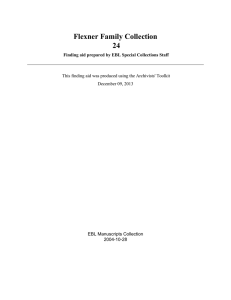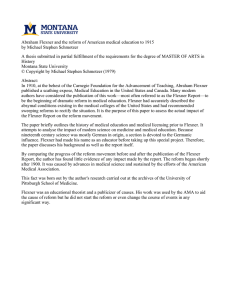Teachers for a New Era
advertisement
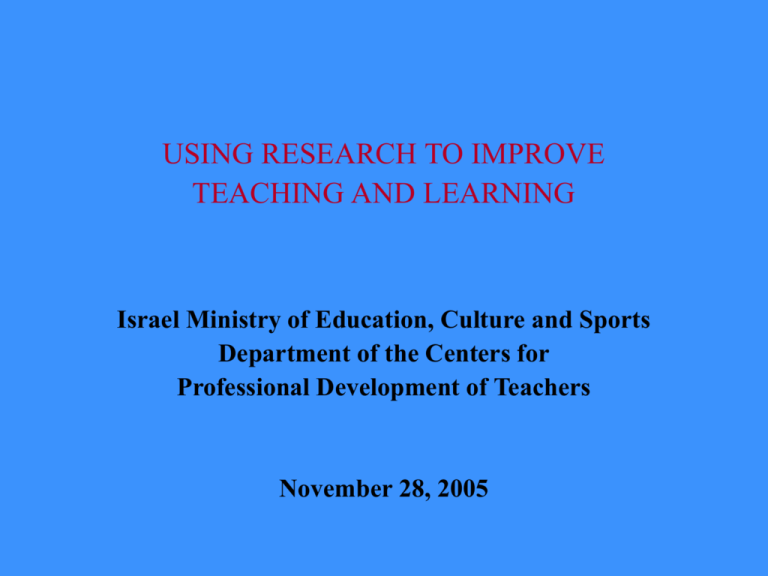
USING RESEARCH TO IMPROVE TEACHING AND LEARNING Israel Ministry of Education, Culture and Sports Department of the Centers for Professional Development of Teachers November 28, 2005 USING RESEARCH TO IMPROVE TEACHING AND LEARNING Edward Crowe Teachers for a New Era Carnegie Corporation of New York Academy for Educational Development National Commission on Teaching and America’s Future Hunter Foundation of Scotland Scottish National Executive High Quality Teacher Preparation Why does it matter? Essential precondition for these outcomes: Student readiness for college success College admissions Student retention in colleges and universities Graduation rate outcomes Compelling evidence that teachers matter… How teachers make a difference Value-added assessment Explaining differences in student learning Differences across districts—5% Across schools within districts—30% Teachers within schools within districts—65% www.sas.com/govedu/edu/research.html How have we responded? Revised accreditation standards and processes Licensure and program approval policies Teacher testing “Highly qualified” teachers Alternate routes into the classroom Evidence that what we’re doing is working? Beginning Teacher Attrition in the United States: A Serious Problem 50% 40% 30% 20% 10% 14% 24% 33% 40% 46% 1st Year 2nd Year 3rd Year 4th Year 5th Year 0% International Study: Why are teachers a focus? Research shows that teaching quality is a key influence on student learning Teachers are the largest item in school budgets: -- The teaching workforce is large (2.5% of total labour force) -- Teachers’ compensation: 63% of spending on schools Teachers’ roles are changing Efforts to improve schools will fail if there are serious shortfalls in teacher supply and quality 8 Teaching Quality Why does it matter? Efforts to improve schools will fail if there are serious shortfalls in teacher supply and quality (OECD) Demonstrable links between teacher experience and student learning (Sanders, New Teacher Center) Impossible to achieve key student learning outcomes without effective teachers: Student readiness for college success Adequate and diverse supply of skilled talent in key employment fields (National Research Council, National Science Foundation, Thomas Friedman) Evidence that what we’re doing is working? Teacher Turnover in the United States A Revolving Door 2,376,677 69% Not In Transition 539,778 16% Leaving 534,861 15% Incoming Total Teaching Force, 1999-2000: 3,451,316 DEVELOPING A RESEARCH AGENDA Professionally Rewarding Career Paths Hiring Incentives Professional Development Performance Pay Board Certification Schools Professional Teacher Preparation Professional Teaching Conditions Professional Teaching Conditions Professionally Rewarding Career Paths Schools Small Schools Leadership and Mentoring Professional Teacher Preparation Professionally Rewarding Career Paths Schools Professional Teaching Conditions Careful Selection, Academic Preparation, Clinical Practice & Induction Residencies, Technology, and Assessment of Teachers & Programs Accreditation, Licensing & Certification Professional Teacher Preparation Professionally Rewarding Career Advancement Conditions for Professional Teaching Practice High-Performing Schools Professional Teacher Preparation Support from Replace Solo Induction to Teaching with Accomplished Learning Teaching, with Communities Professional st Compensation 21 Century Learning Preparation, Induction, Assessment NO DREAM DENIED: A Pledge to America’s Children Organize schools for success Invest in quality teacher preparation Create professionally rewarding careers for teachers www.nctaf.org Some Key Research Questions Teacher Preparation and Professional Development Students Preparing to be Teachers What students bring to the program (student characteristics predictive of success) o Demographics o Attitudes and values o Previous education and work experience Preparing New Teachers (also applies to professional development programs) The “treatment” (the program) and its effects on o Candidate knowledge o Teaching skills and teaching performance Program Outcomes Research on important outcomes o Teaching performance o Persistence in the profession o P-12 student achievement Studying Teacher Education: Report of the AERA Panel on Research and Teacher Education www.aera.net/publications/?id=793 Improving the quality of education research Applying Multiple Social Science Research Methods to Educational Problems American Psychological Association National Research Council American Educational Research Association National Science Foundation www7.nationalacademies.org/cfe/Multiple_Methods_Workshop_Agenda.html Learning from Attempts to Improve Schooling: The Contribution of Methodological Diversity Stephen W. Raudenbush University of Chicago Focus on evaluating the impact of interventions designed to improve teaching and learning Randomized experiments are the gold standard for assessing these effects Learning from Attempts to Improve Schooling: The Contribution of Methodological Diversity Success depends on a well-integrated, methodologically diverse research effort: Precisely define viable instructional aims and outcome variables Identify, refine, and test promising new interventions Clarify the instructional needs of children in various settings Learn whether interventions work, how they work and for whom CONCLUSION: Diverse methods can be combined, and a healthy scientific community should collaborate to achieve these aims Learning from Attempts to Improve Schooling: The Contribution of Methodological Diversity Recommendations “Research using a variety of methods is essential: o To define the student outcomes we seek to change and to build and validate assessments of those outcomes; o To support novel thinking about how best to intervene, to support preliminary studies of those interventions; and o To enable educators to test the feasibility of implementing those interventions in ordinary school settings” --Raudenbush, 2004 National and International Research Efforts On Teaching and Learning Teachers for a New Era Carnegie Corporation of New York Annenberg and Ford Foundations Academy for Educational Development RAND www.teachersforanewera.org Teachers for a New Era 3 design principles Decisions based on evidence Engagement with the arts and sciences Teaching as academically taught clinical profession Teachers for a New Era Key design principle: Decisions based on evidence Assessments linking program preparation to teaching performance Assessments of teacher impact on student learning Teachers for a New Era 11 colleges and universities 4 pupil assessment pilot studies in 2004-05 7 pupil assessment pilot studies in 2005-06 Continuation of first 4 studies in 2005-06 Scottish Teachers for a New Era www.abdn.ac.uk/cass/bulletin/school.shtml#b Improving Teacher Supply and Effectiveness Phillip McKenzie and Paulo Santiago Directorate for Education Meeting of OECD Education Ministers Raisin 34 www.www.oecd.org/edu/teacherpolicy g the Quality of Learning for All Dublin, 18-19 March 2004 Campbell Collaboration • The Campbell Collaboration is an international effort whose mission is to prepare, maintain, and make accessible systematic reviews of studies on the effects of interventions • Funders: Smith Richardson, Robert Wood Johnson, Rockefeller and Knight Foundations; governments of Denmark, Norway, Finland www.campbellcollaboration.org Campbell Collaboration Objectives • Use standards for quality of evidence that are transparent and can be critiqued • Focus on randomized field trials first and on high quality nonrandomized field trials second Campbell Collaboration Systematic reviews of research evidence Randomized trials completed and reviewed: Teacher professional development programs Evaluation of Reading First Program www.campbellcollaboration.org/Bellagio/papers Ohio Teacher Quality Partnership Project Focus • Teacher candidates, impact of program design, program quality outcomes, P-12 student learning • Funding support from Ohio state education and higher education agencies, Knowledge Works Foundation, Carnegie Corporation, Gund Foundation (Ohio), Proctor & Gamble, Joyce Foundation, U.S. Congress www.teacherqualitypartnership.org Teacher Preparation Accountability System Value-Added Teacher Preparation Program Assessment Model Louisiana Board of Regents Board of Elementary and Secondary Education http://asa.regents.state.la.us/TE/value_added_model Teacher Preparation: Does the Pathway Make a Difference? Project Focus Which teachers are most effective in improving student outcomes? What characterizes their preparation, pathways into teaching and qualifications to teach? What is the cost effectiveness of various pathways into teaching? www.teacherpolicyresearch.org Assessments of Teaching Performance CLASS--Classroom Assessment Scoring System [Robert Pianta, University of Virginia] http://convention.allacademic.com/aera2004/ view_presenter.html?part_id1=905783 SOLO--Structure of Observed Learning Outcomes www.learningandteaching.info/learning/solo.htm Reliability and Validity of Instruments Connecting research and practice Developing the missing links Research on Teaching and Learning Value-added studies Some current efforts: Boston Public Schools Dallas Independent School District Denver Public Schools Milwaukee Public Schools RAND study funded by Carnegie Corporation New York State: All 4th grade teachers, 1994-2002 Project Focus: Impact of assessment and accountability Boyd, Lankford, Loeb, and Wyckoff (2005) www.teacherpolicyresearch.org Impact of assessment-based accountability on teacher turnover Since NY State use of fourth grade testing, the turnover rate of fourth grade teachers has decreased relative to teachers in other grades. Decrease is consistent across urban, suburban and rural areas and across schools with differing levels of student performance. Little evidence that high-ability teachers are more likely to leave fourth grade Drop in turnover less for more experienced teachers than for recent hires, especially in suburban districts. New 4th grade teachers in lowest performing schools more likely to have attended highly competitive undergraduate institutions. Public Education Fund-Chattanooga Highly effective teaching High school reform Teacher development--reading and urban education Instructional leadership development www.pefchattanooga.org/www/docs/3/new_society/ www.pefchattanooga.org/www/docs/5/effective_teaching/ Evidence Based Education-UK Create evidence (teaching and learning) Disseminate evidence (to teachers, schools, policy makers) Promote a culture of evidence Work against ‘non-evidence-based’ policy and practice University of Durham Curriculum, Evaluation and Management Centre www.cemcentre.org/ebeuk/default.asp Battelle for Kids Improve teaching and learning Project SOAR Analyze, share and use data 78 Ohio school districts 718 schools 200,000 students (20% of all grades 3-8 in Ohio) SAS Institute www.battelleforkids.com/b4k/rt/about/our_work SAS Institute Schooling effectiveness Schooling effectiveness “technology” Education value-added assessment system (EVAAS) Bill Sanders, June Rivers Papers, resources, other links www.sas.com/govedu/edu/research.html The biggest challenges in research on teacher education and professional development? Keeping the focus on outcomes “In the end the final test of a medical school is its outcome in the matter of clinicians.” Abraham Flexner (1910) Designing and using metrics for success Set goals Establish indicators Measure progress Students Teachers Preparation programs Professional development initiatives Schools Policy After the Test: Closing the Achievement Gaps With Data Bay Area School Reform Collaborative Compared improving and failing schools on achievement gap School culture and leaders supportive of intensive focus on assessment Definition of equity includes student achievement Teachers learn about and use assessment tools regularly Successful schools function as learning communities www.ncrel.org/gap/studies/basrc.htm Value-added assessment studies Teacher Effects Estimate effects of teachers on student learning gains or achievement growth Use of complex models to account for nonrandom pupil assignments, variability in non-school inputs, background variables, student attributes www.rand.org/pubs/monographs/2004/RAND_MG158.sum.pdf Overview of value-added assessment Student learning gains the “gold standard” for evaluating teaching quality and preparation program effectiveness But…. many challenges as research projects move forward with value-added assessment Some value-added challenges Access to relevant data Complexity of methods Research capacity of teacher education programs Commitment to assessment and using evidence P-12 test quality Opening the VAM “black box” Interpreting the results The Flexner Report “Society reaps at this moment but a small fraction of the advantage which current knowledge has the power to confer.” Abraham Flexner (1910) [Bulletin No. 4, Carnegie Foundation for the Advancement of Teaching] www.carnegiefoundation.org Key Flexner Recommendations Medical education in the U.S. and Canada Raise entry standards for students Close 80% of medical schools Strengthen state oversight Faculty should engage in research Practitioners should be scientists Full-time clinical faculty Medical school-hospital clinical ties The future of university teacher preparation? USING RESEARCH TO IMPROVE TEACHING AND LEARNING Edward Crowe Teachers for a New Era Carnegie Corporation of New York Academy for Educational Development National Commission on Teaching and America’s Future Hunter Foundation of Scotland Scottish National Executive
